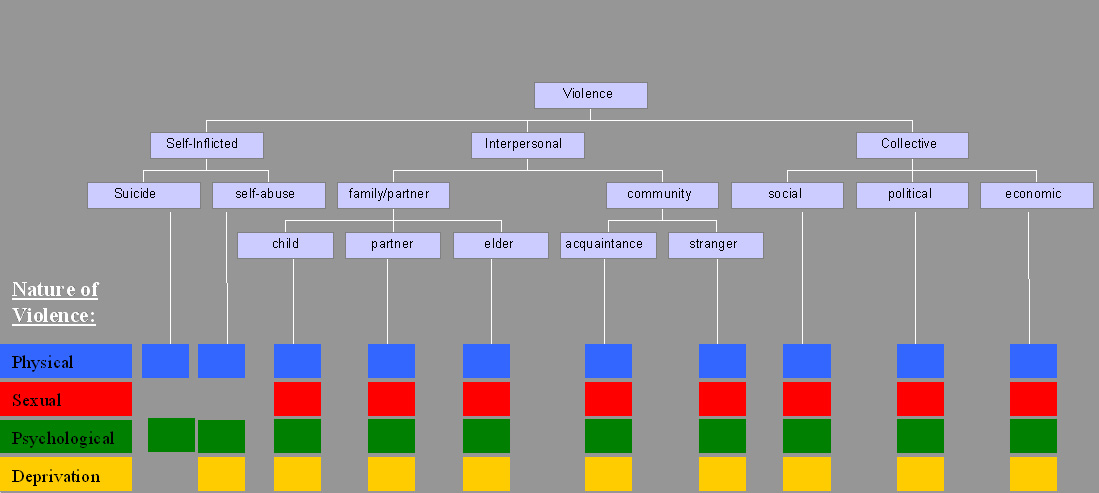|
Aggression
Aggression is behavior aimed at opposing or attacking something or someone. Though often done with the intent to cause harm, some might channel it into creative and practical outlets. It may occur either reactively or without provocation. In humans, aggression can be caused by various triggers. For example, built-up frustration due to blocked goals or perceived disrespect. Human aggression can be classified into direct and indirect aggression; while the former is characterized by physical or verbal behavior intended to cause harm to someone, the latter is characterized by behavior intended to harm the social relations of an individual or group. In definitions commonly used in the social sciences and behavioral sciences, aggression is an action or response by an individual that delivers something unpleasant to another person. Some definitions include that the individual must intend to harm another person. In an interdisciplinary perspective, aggression is regarded as "an ensem ... [...More Info...] [...Related Items...] OR: [Wikipedia] [Google] [Baidu] |
Frustration–aggression Hypothesis
The frustration–aggression hypothesis, also known as the frustration–aggression–displacement theory, is a theory of aggression proposed by John Dollard, Neal Miller, Leonard Doob, Orval Mowrer, and Robert Sears in 1939, and further developed by Neal Miller in 1941 and Leonard Berkowitz in 1989. The theory says that aggression is the result of blocking, or frustrating, a person's efforts to attain a goal. When first formulated, the hypothesis stated that frustration always precedes aggression, and aggression is the sure consequence of frustration. Two years later, however, Miller and Sears re-formulated the hypothesis to suggest that while frustration creates a need to respond, some form of aggression is one possible outcome. Therefore, the re-formulated hypothesis stated that while frustration prompts a behavior that may or may not be aggressive, any aggressive behavior is the result of frustration, making frustration not sufficient, but a necessary condition for aggres ... [...More Info...] [...Related Items...] OR: [Wikipedia] [Google] [Baidu] |
Relational Aggression
Relational aggression, alternative aggression, or relational bullying is a type of aggression in which harm is caused by damaging someone's relationships or social status.McGrath, Mary Zabolio (2006). ''School Bullying: Tools for Avoiding Harm and Liability''. Thousand Oaks, Calif: Corwin Press. p. 21. . Retrieved 2008-09-04. Marion K. Underwood (2003). ''Social Aggression among Girls (Guilford Series On Social And Emotional Development) ''. New York: The Guilford Press. . Retrieved 2008-09-04 Although it can be used in many contexts and among different age groups, relational aggression among adolescents in particular, has received a lot of attention. The attention relational aggression has received has been augmented by the help of popular media, including movies like '' Mean Girls'' and books like ''Odd Girl Out'' by Rachel Simmons (2002), '' Nesthäkchen and the World War'' by Else Ury (1916), and '' Queen Bees and Wannabes'' by R. Wiseman (2003). Relational aggression c ... [...More Info...] [...Related Items...] OR: [Wikipedia] [Google] [Baidu] |
Verbal Aggressiveness
Verbal aggression, also known as verbal abuse, refers to the use of “harsh and insulting language directed at a person”. Verbal aggression in communication has been studied to examine the underlying message of how the aggressive communicator gains control over different things that occur, through the usage of verbal aggressiveness. Scholars have identified that individuals that use verbal aggression have the goal of controlling and manipulating others through language. Infante and Wigley defined verbal aggressiveness as "a personality trait that predisposes persons to attack the self-concept of other people instead of, or in addition to, their positions on topics of communication". Verbal aggressiveness is thought to be mainly a destructive form of communication, but it can produce positive outcomes depending on the context. Infante and Wigley described aggressive behavior in interpersonal communication as a product of an individual's aggressive traits and the way the person p ... [...More Info...] [...Related Items...] OR: [Wikipedia] [Google] [Baidu] |
Anger
Anger, also known as wrath ( ; ) or rage (emotion), rage, is an intense emotional state involving a strong, uncomfortable and non-cooperative response to a perceived provocation, hurt, or threat. A person experiencing anger will often experience physical effects, such as increased heart rate, elevated blood pressure, and increased levels of epinephrine, adrenaline and norepinephrine, noradrenaline. Some view anger as an emotion that triggers part of the fight-or-flight response, fight or flight response. Anger becomes the predominant feeling behavior, behaviorally, cognition, cognitively, and physiology, physiologically when a person makes the conscious choice to take action to immediately stop the threatening behavior of another outside force. Anger can have many physical and mental consequences. The external expression of anger can be found in facial expressions, body language, physiological responses, and at times public acts of aggression. Facial expressions can range from ... [...More Info...] [...Related Items...] OR: [Wikipedia] [Google] [Baidu] |
Violence
Violence is characterized as the use of physical force by humans to cause harm to other living beings, or property, such as pain, injury, disablement, death, damage and destruction. The World Health Organization (WHO) defines violence as "the intentional use of physical force or power, threatened or actual, against oneself, another person, or against a group or community, which either results in or has a high likelihood of resulting in injury, death, psychological harm, maldevelopment, or deprivation"; it recognizes the need to include violence not resulting in injury or death. Categories The World Health Organization (WHO) divides violence into three broad categories: self-directed, interpersonal, and collective. This categorization differentiates between violence inflicted to and by oneself, by another individual or a small group, and by larger groups such as states. Alternatively, violence can primarily be classified as either instrumental or hostile. Self-in ... [...More Info...] [...Related Items...] OR: [Wikipedia] [Google] [Baidu] |
Impulsivity
In psychology, impulsivity (or impulsiveness) is a tendency to act on a whim, displaying behavior characterized by little or no forethought, reflection, or consideration of the consequences. Impulsive actions are typically "poorly conceived, prematurely expressed, unduly risky, or inappropriate to the situation that often result in undesirable consequences," which imperil long-term goals and strategies for success. Impulsivity can be classified as a multifactorial construct. A functional variety of impulsivity has also been suggested, which involves action without much forethought in appropriate situations that can and does result in desirable consequences. "When such actions have positive outcomes, they tend not to be seen as signs of impulsivity, but as indicators of boldness, quickness, spontaneity, courageousness, or unconventionality." Thus, the construct of impulsivity includes at least two independent components: first, acting without an appropriate amount of deliberati ... [...More Info...] [...Related Items...] OR: [Wikipedia] [Google] [Baidu] |
Leonard Berkowitz
Leonard Berkowitz (August 11, 1926 – January 3, 2016) was an American social psychologist best known for his research on altruism and human aggression. He originated the cognitive neoassociation model of aggressive behavior, which was created to help explain instances of aggression for which the frustration-aggression hypothesis could not account. Berkowitz received his Ph.D. in Psychology from the University of Michigan in 1951. He served on the faculty at the University of Wisconsin–Madison from 1955 to 1989. During that period, he also held visiting appointments at Cambridge, Cornell, Oxford, and Stanford Universities. At the time of death, he was a Vilas Research Professor Emeritus in the Department of Psychology at the University of Wisconsin–Madison. During his lifetime, including as recently as two months prior to his death, he authored of over 170 articles, books, and textbooks on psychology. A ''Review of General Psychology'' survey, published in 2002, ranked Berko ... [...More Info...] [...Related Items...] OR: [Wikipedia] [Google] [Baidu] |
John Dollard
John Dollard (29 August 1900 – 8 October 1980) was an American psychologist and social scientist known for his studies on race relations in America and the frustration-aggression hypothesis he proposed with Neal E. Miller and others. Life and education Dollard was born in Menasha, Wisconsin in 1900. He studied commerce and English at the University of Wisconsin and received his B.A. in 1922. He then earned his Ph.D. in sociology at the University of Chicago in 1931. Dollard also studied psychoanalysis at the Berlin Institute from 1931 to 1932. He later returned to the states and taught anthropology at Yale University. He became a research associate at the new Institute of Human Relations while teaching at Yale, and with Neal E. Miller, a fellow researcher at the Institute of Human Relations, Dollard served as a consultant to the Morale Services Division of the U.S. Department of War. He continued to teach at Yale though and later became a professor of psychology in 1952. ... [...More Info...] [...Related Items...] OR: [Wikipedia] [Google] [Baidu] |
Hostility
Hostility is seen as a form of emotionally charged aggressive behavior. In everyday speech, it is more commonly used as a synonym for anger and aggression. It appears in several psychological theories. For instance it is a Facet (psychology), facet of neuroticism in the Revised NEO Personality Inventory, NEO PI, and forms part of personal construct psychology, developed by George Kelly (psychologist), George Kelly. Hostility/hospitality For hunter gatherers, every stranger from outside the small tribal group was a potential source of hostility. Similarly, in archaic Greece, every community was in a state of hostility, latent or overt, with every other community - something only gradually tempered by the rights and duties of hospitality. Tensions between the two poles of hostility and hospitality remain a potent force in the 21st century world. Us/them Robert Sapolsky argues that the tendency to form in-groups and out-groups of Us and Them, and to direct hostility at the latter ... [...More Info...] [...Related Items...] OR: [Wikipedia] [Google] [Baidu] |
Frustration
In psychology, frustration is a common emotional response to opposition, related to anger, annoyance and disappointment. Frustration arises from the perceived resistance to the fulfillment of an individual's Will (philosophy), will or goal and is likely to increase when a will or goal is denied or blocked. There are two types of frustration: internal and external. Internal frustration may arise from challenges in fulfilling Personality psychology, personal objective (goal), goals, Desire (philosophy), desires, drive theory, instinctual drives and needs, or dealing with perceived :wikt:deficiency, deficiencies, such as a lack of confidence or fear of social situations. Emotional conflict, Conflict, such as when one has competing goals that interfere with one another, can also be an internal source of frustration or annoyance and can create cognitive dissonance. External causes of frustration involve conditions outside an individual's control, such as a physical roadblock, a diffi ... [...More Info...] [...Related Items...] OR: [Wikipedia] [Google] [Baidu] |
Behavior
Behavior (American English) or behaviour (British English) is the range of actions of Individual, individuals, organisms, systems or Artificial intelligence, artificial entities in some environment. These systems can include other systems or organisms as well as the inanimate physical environment. It is the computed response of the system or organism to various stimuli or inputs, whether internal or external, conscious or subconscious, overt or covert, and voluntary action, voluntary or Volition (psychology), involuntary. While some behavior is produced in response to an organism's environment (extrinsic motivation), behavior can also be the product of intrinsic motivation, also referred to as "agency" or "free will". Taking a behavior informatics perspective, a behavior consists of actor, operation, interactions, and their properties. This can be represented as a behavior Euclidean vector, vector. Models Biology Definition Behavior may be defined as "the internally coordin ... [...More Info...] [...Related Items...] OR: [Wikipedia] [Google] [Baidu] |





